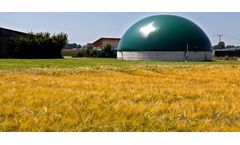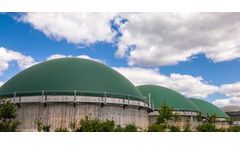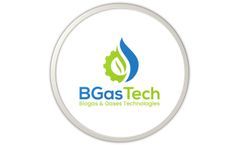Anaerobic Sludge Digestion Technology Articles & Analysis
92 articles found
Critical considerations for anaerobic digestion projects In the field of industrial wastewater treatment, anaerobic digestion is a powerful process that transforms waste into valuable by-products. Most notably, it produces renewable energy in the form of biogas, which can be used to fuel operations, cogenerate electricity, or even be sold. Another valuable by-product of the process is digestate, ...
Biogas production has evolved from a niche practice into a pivotal part of renewable energy, converting organic waste into a clean energy source. Wastewater treatment plants, food waste facilities, and landfill gas recovery systems utilise anaerobic digesters to break down organic matter. This digestion process produces biogas—a mixture of methane and carbon dioxide. Capturing this energy, ...
The annual processing capacity of the plant is approximately 130,000 tons of agricultural biomass, including corn and straw. The biogas generated will be used as a substitute for natural gas for transportation and injected into the natural gas pipeline network. ...
There is enormous potential to increase the extraction of energy from farm waste Agricultural waste is one of the largest sources of methane emitted into the atmosphere from human activities. Methane is a potent greenhouse gas but it’s also highly combustible, making it a valuable source of renewable energy when captured. Anaerobic digesters can convert farm waste into methane-rich ...
Legislation has potential to boost biogas use across the US When anaerobic digestion is used to process wastewater with a high organic load, it produces energy in the form of biogas, a combination of methane, carbon dioxide, and other gases. In the United States, there is huge potential for expansion in anaerobic digestion, but even though the energy produced can more than pay for the treatment, ...
In the dairy industry, the production of biogas can be profitable, even for small farms Dairy farms must deal with wastewater that’s particularly high in organic matter and that can be challenging to deal with. However, establishing an on-farm anaerobic digestion plant that generates biogas from cattle slurry offers several benefits: It captures methane and converts it into a renewable ...
Anaerobic digestion can turn waste into a valuable resource Billions of tons of organic waste are generated every day by households, industries, and municipalities. It’s discarded into landfills or discharged as effluent, or both, at a huge cost to the environment. But what if that waste could be turned into energy? The good news is that it can, through anaerobic digestion. In anaerobic ...
Different technologies can be used to tailor a solution that makes the most of specific feedstocks Anaerobic digestion is a natural biological process in which bacteria decompose organic matter in an oxygen-free environment. ...
Food and beverage operations are ideally positioned to enter the circular economy with waste-to-energy systems The food and beverage (F&B) industry is known for its high-load wastewater. In general, it’s estimated that wastewater sent to treatment utilities contains five times the energy needed to treat it, but the streams from F&B operations are often laden with fat, oil, and ...
Anaerobic digestion is a biological process in which microorganisms break down organic matter without oxygen and transform them into end-products, including biogas, an energy-rich gas comprised of methane (CH4), carbon dioxide (CO2), and other trace amounts of gases. Anaerobic digestion can be summarized as a four-stage process (1) hydrolysis, (2) acidogenesis, (3) acetogenesis, and (4) ...
With an underdeveloped waste-to-energy market, new legislation promotes greater adoption of anaerobic digestion On August 16, United States President Biden signed the $750 billion Inflation Reduction Act (IRA) into law and biogas industry groups immediately hailed its hefty incentives for anaerobic digestion, a technology that recovers energy from waste in the form of ...
SEAFORD, Del. – Bioenergy Devco, LLC, the company creating the new Bioenergy Innovation Center outside of Seaford, shared additional resources to provide accurate, detailed information about anaerobic digestion and the new facility in advance of a public hearing on the project. The Delaware Department of Natural Resources & Environmental Control is holding a virtual public hearing on ...
Converting dairy waste into biogas and other valuable resources trims disposal costs, and saves water and energy Dairy and livestock farmers have been reaping the benefits of converting animal waste into biogas through anaerobic digestion. Now dairy processors are following suit by recycling the organically rich waste that they generate. Instead of discharging waste byproducts into the ...
The anaerobic digestion process is typically used as a means of waste disposal or energy production. Anaerobic digestion of bio-waste in developing countries is extremely beneficial as it doesn’t just generate clean and safe energy, it also contributes towards other economic development issues and has considerable environmental benefits. In this article we will explore the many benefits of the ...
Since 1970, Revico and its subsidiary Revico Energies Vertes have been utilising the by-products of the Cognac sector. Located in Saint-Laurent-de-Cognac (Charente), the company specialises in the treatment of effluents from the production of spirits, such as vinasses or wine dregs. ...
A continuous flow stirred-tank reactor inoculated with anaerobically digested sewage sludge was used by the team to produce hydrogen from biomass-derived sugar. ...
The flow chart in Figure 1 shows a typical WWTP sludge treatment facility via anaerobic digestion, using biogas to meet the energy needs of the process itself and selling surplus energy to the grid. Anaerobic digestion as a means of treatment and recovery of WWTP sludge. ...
DEVELOPMENT . The digestion of sludge, when carried out anaerobically, produces biogas, which is a mixture of gases containing CH4 (which is what gives it its character as a biofuel and contaminant). ...
SILOXANS IN BIOGAS. ORIGIN, EFFECTS AND TREATMENTS Biogas from landfills, digestion and wastewater treatment plants (wwtp) is a valuable material for the production of energy, biofuels and the production of chemical products such as hydrogen and methanol. As it is a source of renewable energy, it is inexhaustible, clean and can be used as planned. Their use generates less environmental ...
Removal of water vapor Origin In the biogas production process, water is an intrinsic part of both the material to be digested (biomass) and the process itself. Furthermore, water is the medium in which biogas production takes place, regardless of whether the digestion process is dry or wet, the biogas produced will contain water vapour. The amount of water vapour contained in the biogas ...















